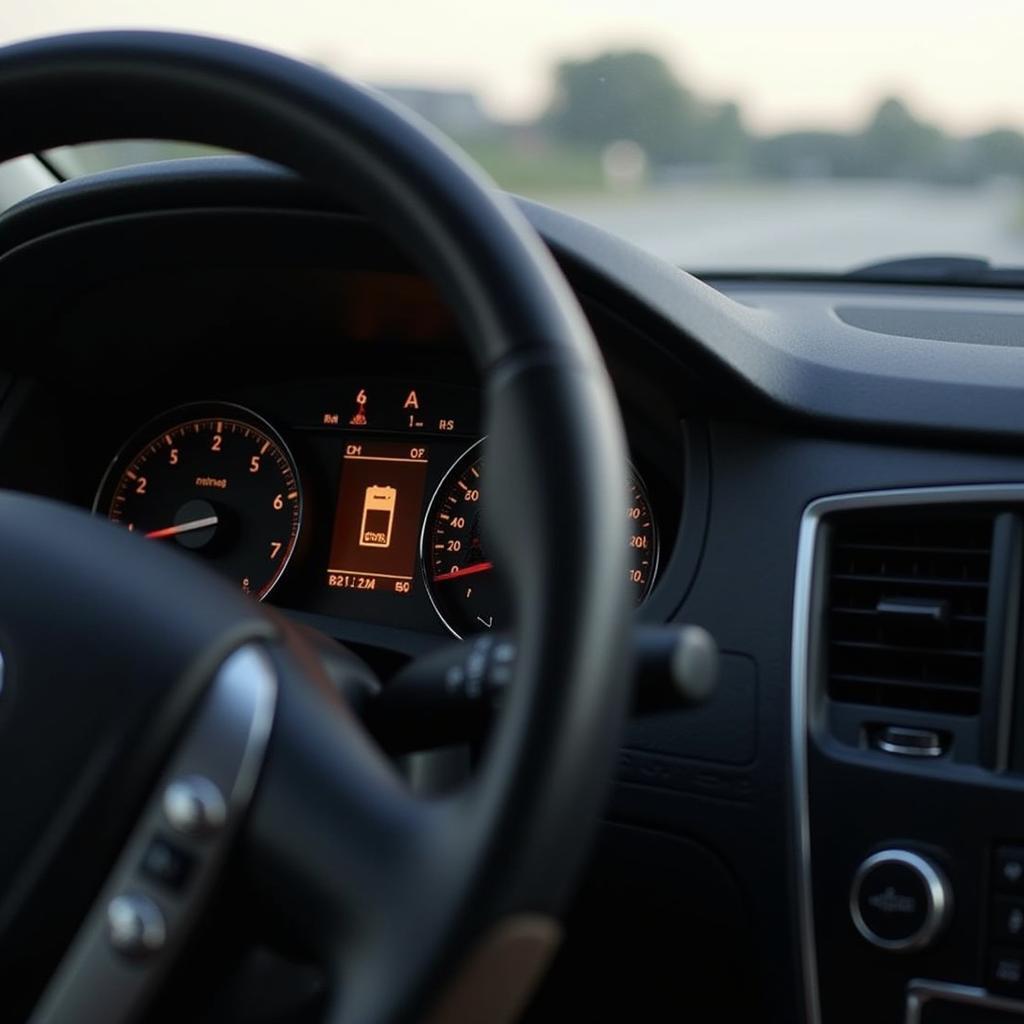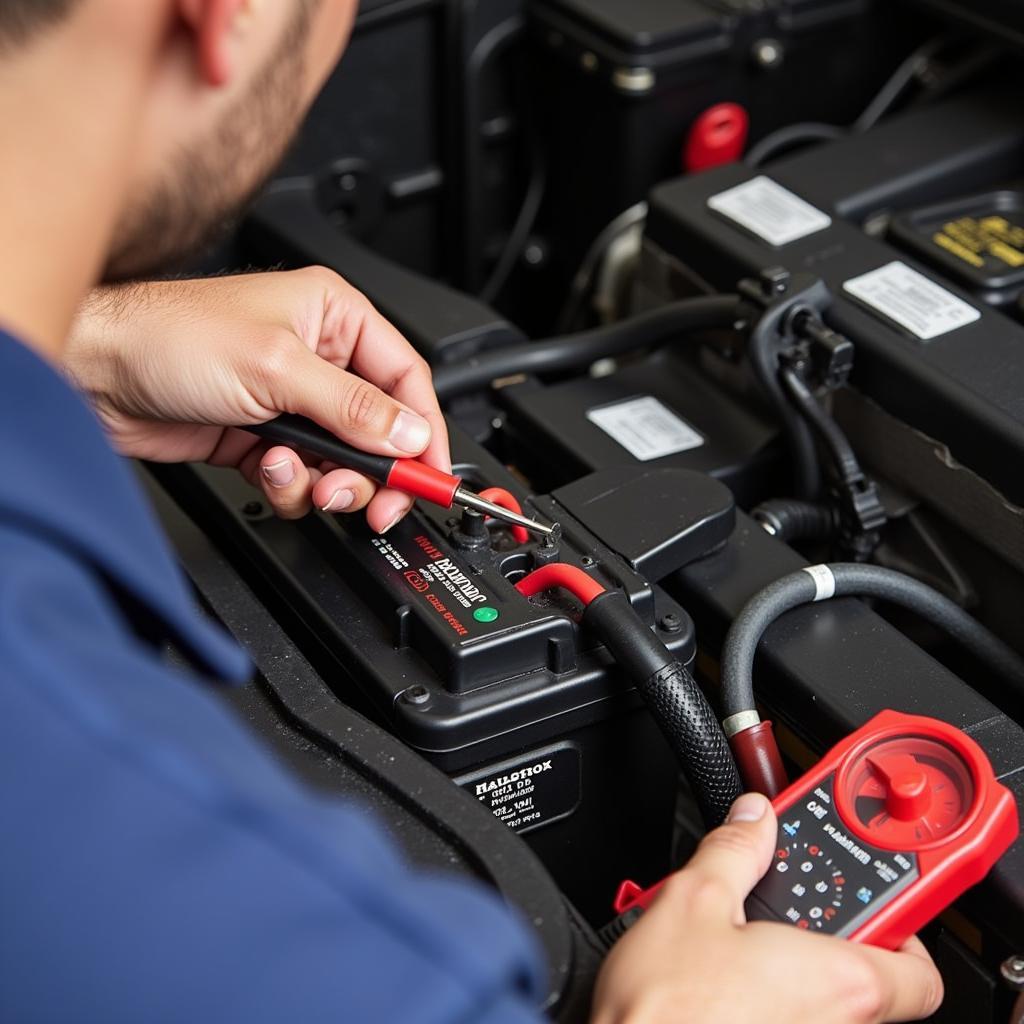The battery indicator on your car dashboard is a crucial warning system, providing insights into the health of your vehicle’s electrical system. A glowing or flickering battery light can signal a range of issues, from a loose battery cable to a failing alternator. Ignoring this warning can lead to significant problems, potentially leaving you stranded. This article will help you decipher what that light means, troubleshoot common causes, and understand when professional help is necessary.
The sudden appearance of a battery light can be alarming. However, understanding what triggers this warning can empower you to take the right steps. It’s important to remember that the battery light doesn’t necessarily mean the battery itself is failing. It indicates a problem with the charging system as a whole. For instance, a faulty alternator, the component responsible for recharging the battery while the engine is running, is a common culprit. Similarly, a worn-out serpentine belt, which powers the alternator, can also trigger the warning light. See our guide on the seat leon key battery warning light.
Common Causes of a Lit Battery Indicator
Several factors can illuminate the battery indicator on your car’s dashboard. Here are some of the most common causes:
- Failing Alternator: The alternator is the heart of your car’s charging system. If it’s malfunctioning, the battery won’t receive the necessary charge.
- Worn or Loose Serpentine Belt: This belt drives the alternator. If it breaks or becomes loose, the alternator can’t function properly.
- Corroded Battery Terminals: Corrosion can disrupt the flow of electricity between the battery and the electrical system.
- Bad Battery Cables: Damaged or loose battery cables can also hinder the flow of electricity.
- Faulty Voltage Regulator: The voltage regulator controls the voltage output of the alternator. A faulty regulator can overcharge or undercharge the battery.
- Parasitic Drain: This occurs when an electrical component continues to draw power even when the car is off, slowly draining the battery.
 Car Battery Light on Dashboard
Car Battery Light on Dashboard
Troubleshooting the Battery Light
When the battery light illuminates, it’s crucial to take action. Here’s a step-by-step guide to help you troubleshoot the problem:
- Check the Battery Terminals: Inspect the battery terminals for corrosion. If present, clean them with a baking soda and water solution. You can learn more about dashboard warning lights in our article about seat leon 2006 dashboard warning lights.
- Inspect the Serpentine Belt: Examine the serpentine belt for wear and tear or looseness. If damaged or loose, it needs replacement.
- Test the Alternator: Use a multimeter to test the alternator’s output voltage. If the voltage is low, the alternator likely needs replacing.
- Check for Parasitic Drain: With the car off, use a multimeter to measure the current draw. A higher-than-normal reading indicates a parasitic drain.
“A simple visual inspection can often reveal obvious issues like corroded terminals or a broken serpentine belt,” says automotive electrical expert, David Miller, ASE Certified Master Technician. “Addressing these simple issues can save you time and money.”
 Testing Car Battery with Multimeter
Testing Car Battery with Multimeter
When to Seek Professional Help
While some battery light issues can be resolved with basic troubleshooting, others require professional expertise. If you’ve checked the obvious culprits and the light persists, it’s best to consult a qualified mechanic. They have the diagnostic tools and knowledge to pinpoint the underlying issue, whether it’s a complex electrical problem, a faulty voltage regulator, or a failing battery requiring replacement. You might find helpful information regarding brake warning indicators in our article on the smart brake support warning indicator.
“Don’t underestimate the complexity of modern vehicle electrical systems,” advises Sarah Chen, an automotive electronics engineer. “Attempting advanced repairs without proper training can lead to further damage and potentially dangerous situations.”
Why is my battery light flickering?
A flickering battery light could indicate a loose connection, a failing alternator, or a problem with the voltage regulator.
Can I drive with the battery light on?
While you might be able to drive a short distance, it’s not recommended. Driving with the battery light on can lead to a complete electrical system failure. Check out our article on the anti lock brake dashboard warning light.
What does a red battery light mean?
A red battery light indicates a problem with the charging system. This could be due to a failing alternator, a loose belt, or a bad battery. You might find helpful information in our article discussing the 2008 hyundai santa fe warning light seat belt battery.
 Mechanic Checking Car Alternator
Mechanic Checking Car Alternator
Conclusion
The battery indicator on your car dashboard is a vital warning sign that shouldn’t be ignored. Understanding its implications, troubleshooting common causes, and knowing when to seek professional help can save you from costly repairs and inconvenient breakdowns. Addressing the issue promptly will ensure your car’s electrical system remains in optimal condition, keeping you safely on the road.

